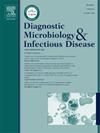Evaluation of PNPLA3 genetic variants in Egyptian HBV-infected patients concomitant with metabolic-associated steatotic liver disease (MASLD)
IF 1.8
4区 医学
Q3 INFECTIOUS DISEASES
Diagnostic microbiology and infectious disease
Pub Date : 2025-09-09
DOI:10.1016/j.diagmicrobio.2025.117105
引用次数: 0
Abstract
Hepatitis B virus (HBV) infection and metabolic-associated steatotic liver disease (MASLD) increasingly coexist, creating complex diagnostic and therapeutic challenges. This study examined the association between the PNPLA3 rs738409 genetic variants and the progression of hepatic steatosis and fibrosis in HBV patients who have and do not have MASLD. A total of 170 Egyptian HBV patients were enrolled and categorized into two groups: non-MASLD (n=99) and MASLD (n=71). The assessment of liver stiffness and hepatic steatosis was conducted using transient elastography (FibroScan®) and controlled attenuation parameter (CAP). Genotyping for PNPLA3 was performed via real-time PCR. The PNPLA3 GG genotype and G allele were significantly linked to the progression of hepatic steatosis in HBV-MASLD patients. Moreover, the frequency of CG+GG genotypes was higher in HBV-MASLD patients during both early (53.1% vs. 34.2%, p=0.035) and late fibrosis stages (73.7% vs. 33.3%, p=0.014) compared to non-MASLD patients. No association was found between PNPLA3 genotypes and HBV DNA levels. HBV viral load was notably associated with different fibrosis stages but was not linked to steatosis. HBV patients carrying the PNPLA3 GG genotype or G allele are more susceptible to developing MASLD and severe steatosis. Additionally, PNPLA3 variants may be implicated in the progression of fibrosis within the context of metabolic dysfunction; this association is not apparent in non-MASLD cases. Furthermore, viral dynamics appear to influence the progression of hepatic fibrosis but not steatosis. The concomitant MASLD in HBV patients was not associated with the severity of hepatic fibrosis.
埃及hbv感染合并代谢相关脂肪变性肝病(MASLD)患者PNPLA3基因变异的评估
乙型肝炎病毒(HBV)感染和代谢相关脂肪变性肝病(MASLD)越来越多地共存,给诊断和治疗带来了复杂的挑战。本研究探讨了PNPLA3 rs738409基因变异与患有或不患有MASLD的HBV患者肝脂肪变性和纤维化进展之间的关系。共有170名埃及HBV患者入组,分为两组:非MASLD (n=99)和MASLD (n=71)。使用瞬时弹性成像(FibroScan®)和可控衰减参数(CAP)评估肝脏硬度和肝脏脂肪变性。采用实时PCR对PNPLA3进行基因分型。pnpla3gg基因型和G等位基因与HBV-MASLD患者肝脂肪变性的进展显著相关。此外,与非masld患者相比,HBV-MASLD患者在纤维化早期(53.1% vs. 34.2%, p=0.035)和晚期(73.7% vs. 33.3%, p=0.014)出现CG+GG基因型的频率更高。PNPLA3基因型与HBV DNA水平无相关性。HBV病毒载量与不同纤维化阶段显著相关,但与脂肪变性无关。携带pnpla3gg基因型或G等位基因的HBV患者更容易发生MASLD和严重脂肪变性。此外,在代谢功能障碍的情况下,PNPLA3变异可能与纤维化进展有关;这种关联在非masld病例中并不明显。此外,病毒动力学似乎影响肝纤维化的进展,但不影响脂肪变性。HBV患者伴随的MASLD与肝纤维化的严重程度无关。
本文章由计算机程序翻译,如有差异,请以英文原文为准。
求助全文
约1分钟内获得全文
求助全文
来源期刊
CiteScore
5.30
自引率
3.40%
发文量
149
审稿时长
56 days
期刊介绍:
Diagnostic Microbiology and Infectious Disease keeps you informed of the latest developments in clinical microbiology and the diagnosis and treatment of infectious diseases. Packed with rigorously peer-reviewed articles and studies in bacteriology, immunology, immunoserology, infectious diseases, mycology, parasitology, and virology, the journal examines new procedures, unusual cases, controversial issues, and important new literature. Diagnostic Microbiology and Infectious Disease distinguished independent editorial board, consisting of experts from many medical specialties, ensures you extensive and authoritative coverage.

 求助内容:
求助内容: 应助结果提醒方式:
应助结果提醒方式:


